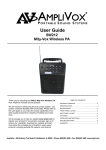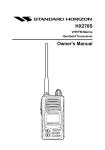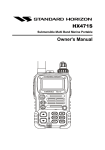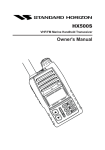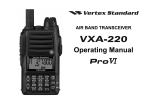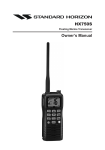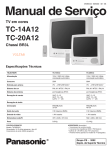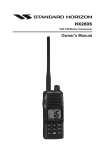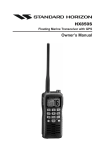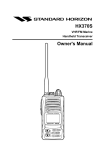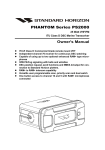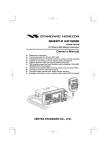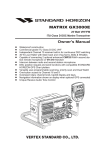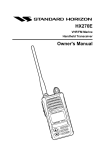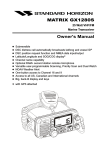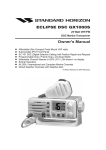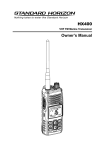Download HX500 User Manual - Standard Horizon
Transcript
HX500E VHF/FM Marine Handheld Transceiver Owner's Manual 16/9 DW H/L TABLE OF CONTENTS ABOUT VHF MARINE BAND ........................................................................................................ 1 1. GENERAL INFORMATION ........................................................................................................ 2 1.1 INTRODUCTION ................................................................................................................. 1 2. ACCESSORIES .......................................................................................................................... 3 2.1 PACKING LIST ..................................................................................................................... 3 2.2 OPTIONS ............................................................................................................................. 3 3. GETTING STARTED .................................................................................................................. 4 3.1 BATTERIES AND CHARGERS ........................................................................................... 4 4. CONTROLS AND SWITCHES ................................................................................................... 8 5. BASIC OPERATION ................................................................................................................. 11 5.1 INITIAL SETUP .................................................................................................................. 11 5.2 RECEPTION ....................................................................................................................... 11 5.3 TRANSMISSION ................................................................................................................ 12 5.4 PRESET CHANNELS (0 ~ 9) ............................................................................................. 13 5.5 ENABLING S.O.S STROBE OPERATION ........................................................................ 13 6. ADVANCED OPERATION ON THE MARINE BAND .............................................................. 14 6.1 USA, CANADA, AND INTERNATIONAL CHANNELS ...................................................... 14 6.2 MEMORY SCAN ................................................................................................................. 14 6.3 PROGRAMMABLE PRIORITY SCAN ............................................................................... 15 6.4 DUAL WATCH .................................................................................................................... 16 6.5 TRI WATCH ........................................................................................................................ 16 6.6 EMERGENCY CHANNEL 16 ............................................................................................. 16 6.7 CHANNEL 9 ........................................................................................................................ 17 6.8 OPERATING ON CHANNEL 13 ........................................................................................ 17 6.9 OPERATING ON CHANNEL 67 ........................................................................................ 17 6.10 SIMPLEX/DUPLEX CHANEL USE .................................................................................. 17 7. OPERATING PRACTICE ......................................................................................................... 23 7.1 EMERGENCY (CHANNEL 16 USE) .................................................................................. 18 7.2 CALLING ANOTHER VESSEL (CHANNEL 16 OR 9) ...................................................... 18 7.3 OPERATING ON CHANNEL 13 AND 67 ........................................................................... 19 8. MENU (“SET”) MODE ............................................................................................................. 20 9. INSTALLATION OF OPTIONS ................................................................................................. 22 9.1 FBA-25A ALAKLINE BATTERY TRAY .............................................................................. 22 10. MAINTENANCE ...................................................................................................................... 23 10.1 GENERAL ......................................................................................................................... 23 10.2 TROUBLESHOOTING CHART ...................................................................................... 23 11.VHF MARINE CHANNEL ASSIGNMENT ............................................................................... 34 12. SPECIFICATIONS .................................................................................................................. 30 HX500E Congratulations on your purchase of the HX500E! Whether this is your first portable marine VHF transceiver, or if you have other STANDARD HORIZON equipment, the STANDARD HORIZON organization is committed to ensuring your enjoyment of this high performance transceiver, which should provide you with many years of satisfying communications even in the harshest of environments. STANDARD HORIZON technical support personnel stands behind every product sold, and we invite you to contact us should you require technical advice or assistance. We appreciate your purchase of the HX500E, and encourage you to read this manual thoroughly, so as to learn and fully understand the capabilities of the HX500E. ABOUT VHF MARINE BAND The radio frequencies used in the VHF marine band lie between 156 and 158 MHz with some shore stations available between 161 and 163 MHz. The marine VHF band provides communications over distances that are essentially “line of sight” Actual transmission range depends much more on antenna type, gain and height than on the power output of the transmitter. A portable 5W radio transmission expected distance can be greater than 5 miles “line of sight.” 16/9 DW H/L HX500E The user of a Marine VHF radio is subject to severe fines if the radio is used on land. The reasoning for this is you may be near an inland waterway, or propagation anomalies may cause your transmission to be heard in a waterway. If this occurs, depending upon the marine VHF channel on which you are transmitting, you could interfere with a search and rescue case, or contribute to a collision between passing ships. For VHF Marine channel assignments refer to page 24 section 11. Page 1 1. GENERAL INFORMATION 1.1 INTRODUCTION The HX500E is a SUBMERSIBLE miniature 5-Watt portable two-way marine transceiver. The transceiver has all allocated USA, International, or Canadian channels. It has emergency channel 16 which can be immediately selected from any channel by pressing the [16/9] key. The HX500E includes the following features: Memory Scanning, Priority Scanning, Battery Saver, easy-to-read large LCD display, EEPROM memory backup, Battery Life displayed on LCD, Transmit Time-Out Timer (TOT) and a strobe light when enabled blinks the internationally recognized SOS distress signal. The transmitter provides a maximum of 5 Watts output, and has the selection of 2.5 Watts and 1 Watt to assist the user in ensuring maximum battery life. Page 2 HX500E 2. ACCESSORIES 2.1 PACKING LIST When the package containing the transceiver is first opened, please check it for the following contents: • • • • • • • HX500E Transceiver CAT460 Antenna FNB-83 7.2 V, 1400 mAh Ni-MH Battery Pack CD-32 Charger Cradle for HX500E NC-88C/U 230 VAC Overnight Charger for CD-32 E-DC-19A DC Cable with 12 V Cigarette Lighter Plug for CD-32 Owner’s Manual 2.2 OPTIONS CMP460 Noise-canceling Waterproof Speaker/Microphone MH-57A4B Mini Speaker/Microphone VC-24 VOX Headset VC-27 Earpiece/Microphone CD-32 Charger Cradle FNB-83 7.2 V, 1400mAh Ni-MH Battery Pack FBA-25A Alkaline Battery Case E-DC-19A DC Cable with 12 V Cigarette Lighter Plug NC-88B/C/U 120/230 VAC Overnight Charger for the FNB-83 E-DC-6 DC Cable; plug and wire only VAC-10 CAW230 Rapid Charger Radio-to-Ship’s-Antenna Adapter Note: Before operating the HX500E for the first time, it is recommended that the battery be charged. Please see section 3.1.4 “USING THE CD-32 CHARGER CRADLE” for details. HX500E Page 3 3. GETTING STARTED If the radio has never been used, or its charge is depleted, it may be charged by connecting the CD-32 Charger Cradle with the NC-88 battery charger, as shown in the illustration. If 12V DC power is available, the supplied E-DC19A DC Cable with 12 V Cigarette Lighter Plug or the optional E-DC-6 DC Cable may be used for charging the battery. The NC-88 and E-DC-6 will charge a completely discharged FNB-83 battery pack in about 10 hours. 3.1 BATTERIES AND CHARGERS The FNB-83 is a high performance Nickel-Metal-Hydride battery providing high capacity in a compact package. CAUTION To avoid risk of explosion and injury, FNB-83 battery pack should only be removed, charged or recharged in non-hazardous environments. 3.1.1 BATTERY SAFETY Battery packs for your transceiver contain Ni-MH batteries. This type of battery stores a charge powerful enough to be dangerous if misused or abused, especially when removed from the transceiver. Please observe the following precautions: DO NOT SHORT BATTERY PACK TERMINALS: Shorting the terminals that power the transceiver can cause sparks, severe overheating, burns, and battery cell damage. If the short is of sufficient duration, it is possible to melt battery components. Do not place a loose battery pack on or near metal surfaces or objects such as paper clips, keys, tools, etc. When the battery pack is installed on the transceiver, the terminals that transfer current to the transceiver are not exposed. The terminals that are exposed on the battery pack when it is mounted on the transceiver are charging terminals only and do not constitute a hazard. DO NOT INCINERATE: Do not dispose of any battery in a fire or incinerator. The heat of fire may cause battery cells to explode and/or release dangerous gases. Page 4 HX500E Battery Maintenance For safe and proper battery use, please observe the following: • Battery packs should be charged only in non-hazardous environments; • Use only STANDARD HORIZON-approved batteries; • Use only a STANDARD HORIZON, (a Marine Division of VERTEX STANDARD) approved charger. The use of any other charger may cause permanent damage to the battery. • Follow charging instructions provided with the chargers. • Keep the battery contacts clean. Battery Storage Store batteries in a cool place to maximize storage life. Since batteries are subject to self-discharge, avoid high storage temperatures that cause large self-discharge rates. After extended storage, a full recharge is recommended. Battery Recycling DO NOT PLACE USED BATTERIES IN YOUR REGULAR TRASH! NICKEL-METAL-HYDRIDE BATTERIES MUST BE COLLECTED, RECYCLED OR DISPOSED OF IN AN ENVIRONMENTALLY SOUND MANNER. The incineration, land filling or mixing of nickel-cadmium batteries with the municipal solid waste stream is PROHIBITED BY LAW in most areas. Return batteries to an approved Nickel-Metal-Hydride battery recycler. This may be where you purchased the battery. Contact your local waste management officials for other information regarding the environmentally sound collection, recycling and disposal of Nickel-Metal-Hydride batteries. HX500E Page 5 3.1.2 BATTERY CHARGING If the radio has never been used, or its charge is depleted, it may be charged by connecting the CD-32 Charger Cradle with the NC-88 battery charger, as shown in the illustration. If 12V DC power is available, the supplied E-DC19A DC Cable with 12 V Cigarette Lighter Plug or the optional E-DC-6 DC Cable may be used for charging the battery. The NC-88, E-DC-19A and E-DC-6 will charge a completely discharged FNB-83 battery pack in about 10 hours. NC-88 E-DC-6 E-DC-19A 3.1.3 BATTERY INSTALLATION/REMOVAL 1. Turn the transceiver off. 2. To install, insert the battery pack into the battery compartment on the back of the transceiver, then close the Battery Pack Latch until it locks in place with a “click.” Install the Battery Pack Close the Battery Pack Latch 3. To remove, open the Battery Pack Latch on the bottom of the transceiver, then slide the battery downward and out from the transceiver. Page 6 HX500E 3.1.4 USING THE CD-32 CHARGER CRADLE 1. Turn the transceiver off. 2. Insert the DC plug from the NC-88 into the DC jack on the CD-32 side panel, then plug the NC-88 into the AC line outlet. 3. Insert the HX500E (with the battery pack) into the CD-32; the antenna should be at the left side when viewing the charger from the front. 4. If the HX500E is inserted correctly, the Red indicator on the CD-32 will glow. A fully-discharged pack will be charged completely in approximately 10 hours. Important Note: Do not leave the charger connected to the transceiver for continuous periods in excess of 24 hours. Long term overcharging can degrade the Ni-MH battery pack and significantly shorten its useful life. 5. When charging is completed, disconnect the pack from the CD-32, and unplug the NC-88 from the AC line outlet. 3.1.5 MOUNTING THE CD-32 ON THE VESSEL The CD-32 is designed to be surface on a vessel which can be connected to the charger. If mounting on a vessel, the CD-32 must be mounted in a location on the vessel that is directly shielded from rain or splashes of water. After the location is found, mount the CD-32 using the supplied mounting screws. CD-32 Desktop Mount HX500E Page 7 4. CONTROLS AND SWITCHES NOTE This section defines each control of the transceiver. For detailed operating instructions, refer to section 5 “BASIC OPERATION.” Refer to illustrations for the location of the following controls, switches, and connections. 16/9 DW H/L VOLUME CONTROL Turn this control clockwise to increase the volume. MIC/SP JACK The jack accepts the optional CMP460 Speaker/Microphone, MH-57A4B Mini Speaker/Microphone, VC-24 VOX Headset or VC-27 Earpiece/Microphone. When this jack is used, the internal speaker is disabled. Page 8 HX500E ANTENNA CONNECTOR The supplied CAT460 flexible antenna is attached here. PUSH-TO-TALK (PTT) SWITCH When pushed activates the transmitter. SQUELCH (SQL) SWITCH Sets the point at which random noise on the channel will not activate the audio circuits but a received signal does. This point is called the Squelch threshold. Further adjustment of the squelch control will degrade the reception of wanted transmissions. To quickly open the squelch and monitor a channel before transmitting, press and hold this key for 3 seconds. POWER SWITCH Press and hold in this switch for 2 seconds to toggle the transceiver’s power “on” and “off.” [S(UP)] KEY Press to select a desired channel. Each press increases the channel number. When held down, the channels increase continuously. [T(DOWN)] KEY Press to select a desired channel. Each press decreases the channel number. When held down, the channels decrease continuously. MICROPHONE The internal microphone is located here. [16/9] KEY Immediately recalls channel 16 from any marine channel or band location. Holding down this key recalls channel 9. [DW] KEY Press the [DW] key, scan for voice communications on the priority channel and another selected channel until a sognal is received on either channel (Dual Watch). Refer to section “6.4 DUAL WATCH” for details. HX500E Page 9 [H/L] KEY On the Marine Band, changes the transmitter output power between High (5 Watts), Medium (2.5 Watts), and Low (1 Watt). Does not operate on “Low power only” and transmission-inhibit channels. When operating on Canadian channel 13, or USA channels 13 or 67, pressing this key momentarily toggles the power level from Low power to medium or High power. Secondary use: Hold down this key to lock the keypad (except the PTT, SQL, and [H/L] keys) so that they are not accidentally changed. The key lock symbol “ ” will appear on the LCD, to indicate that the functions are locked. Hold down until the key lock symbol “ ” disappears to unlock the radio. [SCAN] KEY Starts scanning and priority scanning of programmed channels. When scanning, press and hold this key to turn on and off priority scan (“P” is shown on the display during Priority scanning). [PRESET] KEY Immediately recalls one of up to 10 user preset memories for each band (shown as 0-9 on the LCD). Pressing this key repeatedly scrolls through the preset memory channels. [MEM] KEY Press this key to memorize the selected channel for scanning. When pressed a “MEM” icon will be shown on the LCD display indicating the channel has been saved to scan memory. The scan memory is only used with the Marine and WX channels. To delete the channel from scan memory, select the channel and press this key until “MEM” is removed from the display. BUSY/TX INDICATOR This indicator glows green when a signal is being received and red when transmitting. When the Emergency feature is activated, this indicator blinks the internationally-recognized Morse Code “S.O.S.” message. Page 10 HX500E 5. BASIC OPERATION 5.1 INITIAL SETUP 1. Install the battery pack on the transceiver (see section 3.1.3 “BATTERY INSTALLATION/REMOVAL”). 2. Install the antenna onto the transceiver. NOTE: Water resistance of the transceiver is assured only when the battery pack and antenna are attached to the transceiver and MIC/SP rubber cap is installed in the MIC/SP jack. 5.2 RECEPTION 1. Press and hold in the POWER switch for two seconds to turn the transceiver on. 2. Press the SQL switch, then press the [T] key until the SQL level is 00. This state is known as “Squelch Off.” 3. Turn up the VOLUME CONTROL knob until the noise or audio from the speaker is at a comfortable level. 4. Press the [S] or [T] key to select a channel or frequency that has no signal being received (no one is transmitting on the channel) and where only noise is heard. 5. Press the SQL switch, then press the [S] key and stop immediately after the noise disappears. This condition is known as the “Squelch Threshold.” If the squelch is set to a higher level, weak signals may not be received. No noise or no signal is heard until a signal is received that exceeds the squelch threshold. Sometimes, a slight adjustment of the squelch threshold is needed, as some channels have a higher noise level than others. NOTE: To quickly open the squelch and monitor a channel before transmitting, press and hold this key for 3 seconds. 6. Press the [SCAN] key momentarily to channel the scanning. Refer to section 6.2 for programming channels into scan memory. 7. Please refer to section 11 for VHF Marine channel assignments. 8. The LCD and keypad are illuminated for 5 seconds when any key is pressed. The lamp automatically turns off in about 5 seconds. 9. To “lock” the channel so that it is not accidentally changed, hold down the [H/L] key for about one second. This locks the [S] and [T] keys and all the front panel controls except the [H/L], PTT and SQL keys. The “ ” symbol will appear on the display to indicate that the keypad is locked. HX500E Page 11 Hold down the [H/L] key for about one second to unlock the keys. The “ ” symbol will disappear from the display. 5.3 TRANSMISSION 1. Perform steps 1 through 5 of the RECEPTION discussion above. 2. Before transmitting, monitor the channel and make sure it is clear. 3. For communications over short distances on the Marine band, press the [H/L] key until “ ” is displayed on the LCD. This indicates Low power (approximately 1 watt). Note Transmitting on 1 watt prolongs battery life. Low power (1 watt) should be selected whenever possible. 4. If using Low power is not effective, select Medium power (2.5 watts) or High power (5 watts) by pressing the [H/L] key until “ ” (Medium power) or “ ” (High power) is displayed. 5. When receiving a signal, wait until the incoming signal stops before transmitting. The transceiver cannot transmit and receive simultaneously. 6. Press the PTT (Push-To-Talk) switch to transmit. The “ ” indicator is displayed during transmission. 7. Speak slowly and clearly into the microphone. Hold the microphone about 1/2 to 1 inch away from your mouth. 8. When the transmission is finished, release the PTT switch. For an overview of VHF Marine band operating procedures refer to section 3. 5.3.1 TRANSMIT TIME - OUT TIMER (TOT) While the PTT switch is held down, transmission time is limited to 5 minutes. This prevents prolonged (unintentional) transmissions. About 10 seconds before automatic transmitter shutdown, a warning beep sounds from the speaker. The transceiver automatically switches to the receiving mode, even if the PTT switch is held down. Before transmitting again, the PTT switch must first be released, and then pressed again. This Time-Out-Timer (TOT) prevents a continuous transmission that would result from an accidentally stuck PTT switch. Page 12 HX500E 5.4 PRESET CHANNELS (0 ~ 9): INSTANT ACCESS Ten user-assigned channels can be programmed for instant access. Programming 1. Hold down the [PRESET] key, and press the [S] or [T] key (repeatedly, if necessary) until the desired channel number is displayed. 2. With the desired number displayed, release the [PRESET] key. 3. Repeat steps 2 and 3 to program the desired channels into Preset Channels “0” ~ “9.” 4. To delete a Preset Channel, hold down the [PRESET] key and press the [S] or [T] key until the Preset Channel number to be deleted is displayed, then release the [PRESET] key. Operation Pressing the [PRESET] key will toggle between Preset Channels “0” - “9” and the last selected “regular” channel. Preset Channel “0” is represented by “0” to the right of the channel number on the LCD for 1 second, and preset channel “1” is represented by “1” and so forth. The preset channel number will disappear after a few seconds. Note:You may add an alphanumeric name “Tag” to any desired Preset Channel; refer to CH NAME SET item on the section 8 “MENU (“SET”) MODE.” 5.5 ENABLING S.O.S. STROBE OPERATION The S.O.S. STROBE feature utilizes the high-intensity strobe LED on the front of the HX500E as a visual distress beacon. When enabled, the LED blinks the internationally recognized Morse Code “S.O.S.” message (• • • – – – • • •) at a rate of 5 words per minute. This can be very useful in summoning help from rescuers who may not be able to communicate with you via radio. 1. Hold down the [MEM] key while turning the radio on to activate the emergency S.O.S. Strobe. Once the radio comes on, the BUSY/TX LED will flash the Morse Code S.O.S. message repeatedly. 2. The S.O.S. strobe function is interrupted when a signal is received or if the squelch control is turned so audio is heard from the speaker. and during transmission. 3. To disable the S.O.S. strobe function, turn the radio off and back on again. HX500E Page 13 6. ADVANCED OPERATION ON THE MARINE BAND 6.1 USA, CANADIAN, AND INTERNATIONAL CHANNELS 1. To change from US to Canadian or International Marine Channels, hold down the [16/9] key and press the [DW] key. The band will change from USA, to International, and to Canadian with each press. 2. “USA” appears on the LCD for the USA band, “INTL” appears for the International band, and “CAN” appears for the Canadian band. 3. Refer to the marine channel charts in section 11 “VHF MARINE CHANNEL ASSIGNMENTS” for allocated channels. 6.2 MEMORY SCAN The HX500E can be programmed to scan channels from a minimum of 2 channels up to all channels in the marine band. If an incoming signal is detected on one of the channels during scan, the radio will pause on that channel, allowing you to listen to the incoming transmission. 1. Press the SQL switch then the [S] or [T] key until the background noise from the speaker is turned off. 2. Select the desired channel to be included in the scan memory using the [S] or [T] key. 3. Press the [MEM] key to store the channel into the transceiver’s scan memory. “MEM” will be displayed on the LCD. 4. Repeat steps 1 and 2 for all the channels to be scanned. 5. To delete a channel from the transceiver’s scan memory select the memorized channel. Press the [MEM] key, “MEM” indicatin will be removed from the display. 6. To start scanning, press the [SCAN] key. The scan proceeds from the lowest to the highest programmed channel and stops scanning when a transmission is received. Scanning will resume when the incoming signal disappears at the end of the transmission. A small “SCAN” icon is shown on the display during scanning. 7. To stop the scan, press the [SCAN] key. Page 14 HX500E 6.3 PROGRAMMABLE PRIORITY SCAN The priority scanning feature allows the radio to scan while also keeping watch on a particularly important “priority channel.” The following channels can be set as the priority channel: 16, 09, and MARINE Preset Channel. 1. To set the priority channel, hold down the [16/9] key and press the [MEM] key. The channel will change from 16 to 09 to Preset Channels 0 through 9 with each press of the [MEM] key. When the [16/9] key is released the displayed channel will be set as the priority channel (the large “P” icon will appear at the left side of the channel number). 2. For priority scanning, hold down the [SCAN] key during normal scanning. Scanning will proceed between the memorized channels and the priority channel. The priority channel will be scanned after each programmed channel. “P” is shown on the left side of the channel number during priority scanning. 3. As an example of priority scanning, let us say that marine channels 06, 07, and 08 are memorized in the transceiver’s scan memory. Priority scanning will proceed in the following sequence: [CH06] Æ [Priority Channel] Æ [CH07] Æ [Priority Channel] Æ [CH08] Æ [Priority Channel] Æ [CH06] Æ [Priority Channel] …… 4. Even when the transceiver stops and listens to the signal of a programmed channel, the transceiver will shift to a “dual watch” mode between this channel and the priority channel. Therefore, your priority watching of the designated channel is not compromised when the scanner has paused on an active channel. 5. Hold down the [SCAN] key to change the priority scanning to normal scanning, and then press the [SCAN] key to stop the scan and return to normal operation. HX500E Page 15 6.4 DUAL WATCH The Dual Watch feature allows the radio to watch for a transmission on the priority channel and another selected Marine channel until a signal is received. The priority channel is determined in section 6.3 “PROGRAMMABLE PRIORITY SCAN”. 1. To start the Dual Watch feature, select a channel to be dual watched with the priority channel and press and hold the [SCAN] key. The radio checks the priority channel for voice traffic every one second. A small “DW” icon is will be shown blinking on the left of the display during scanning. 2. To cancel the Dual Watch feature, press the [SCAN] key. 6.5 TRI WATCH Note:To use this function the radio must be setup to enable the Tri-watch function. Refer to Section 8 “MENU (“SET”) MODE”. The TRI Watch feature allows the radio to watch for a transmission on the priority channel, and the secondary calling channel (channel 09) and another selected Marine channel until a signal is received. The priority channel is determined per the discussion in section 6.3 “PROGRAMMABLE PRIORITY SCAN”. 1. To start the TRI Watch feature, select a channel and press and hold the [SCAN] key. The radio checks the priority channel, CH09 and the selected channel for voice traffic. A small “DW” icon is will be shown blinking on the left of the display during scanning. 2. To cancel the TRI Watch feature, press the [SCAN] key. 6.6 EMERGENCY CHANNEL 16 1. To select the emergency channel, press the [16/9] key from any channel. 2. If you cannot contact anyone on channel 16, switch to another channel. 3. See section 7.1 “EMERGENCY (CHANNEL 16 USE)” for additional emergency operating practices. 4. To recall the previously-used channel when you are finished on channel 16, press the [16/9] key again. Page 16 HX500E 6.7 CHANNEL 9 Channel 9 is used as a hailing channel for initial, non-emergency contacts with other vessels. Hold down the [16/9] key for 1 second to select channel 9. You should change to a working channel, after contact is established (so as to keep the hailing channel clear for other users). 6.8 OPERATING ON CHANNEL 13 Channel 13 is used at docks, bridges and for maneuvering in port. Messages on this channel must concern navigation only, such as meeting and passing in restricted waters. In emergencies and when approaching blind river bends, high power is allowed. Pressing the [H/L] key will change the power output from 1 Watt ( ) to 5 Watts ( ); if pressed again, 2.5 Watts ( ) will be selected. When the PTT switch is released, the transceiver will revert to Low power. Press the [H/L] key again if you need High power on a subsequent transmission. 6.9 OPERATING ON CHANNEL 67 When channel 67 is used for navigational bridge-to-bridge traffic between ships. This channel has been allocated for temporary high power transmission if communication is not able to be established on one watt. Select Channel 67, then press the [H/L] key to set the transmitter output to either High or Medium power. When the PTT switch is released, the transceiver will revert to low power. 6.10 SIMPLEX/DUPLEX CHANNEL USE All Marine channels are factory-programmed in accordance with FCC (USA), Industry Canada and International regulations. The mode of operation cannot be altered from simplex to duplex or vice-versa. Simplex (ship to ship) or duplex (marine operator) mode is automatically activated, depending on the channel and whether the USA, International or Canadian operating band is selected. HX500E Page 17 7. OPERATING PRACTICES 7.1 EMERGENCY (CHANNEL 16 USE) Channel 16 is known as the Hail and Distress Channel. An emergency may be defined as a threat to life or property. In such instances, be sure the transceiver is on and set to CHANNEL 16. Then use the following procedure: 1. Press the microphone push-to-talk switch and say “Mayday, Mayday, Mayday. This is , , ” (your vessel’s name). 2. Then repeat once: “Mayday, ” (your vessel’s name). 3. Now report your position in latitude/longitude, or by giving a true or magnetic bearing (state which) to a well-known landmark such as a navigation aid or geographic feature such as an island or harbor entry. 4. Explain the nature of your distress (sinking, collision, aground, fire, heart attack, life-threatening injury, etc.). 5. State the kind of assistance your desire (pumps, medical aid, etc.). 6. Report the number of persons aboard and condition of any injured. 7. Estimate the present seaworthiness and condition of your vessel. 8. Give your vessel’s description: length, design (power or sail), color and other distinguishing marks. The total transmission should not exceed 1 minute. 9. End the message by saying “OVER”. Release the microphone button and listen. 10. If there is no answer, repeat the above procedure. If there is still no response, try another channel. 7.2 CALLING ANOTHER VESSEL (CHANNEL 16 OR 9) Channel 16 may be used for initial contact (hailing) with another vessel. However, its most important use is for emergency messages. This channel must be monitored at all times except when actually using another channel. It is monitored by the U.S. and Canadian Coast Guards and by other vessels. Use of channel 16 for hailing must be limited to initial contact only. Calling should not exceed 30 seconds, but may be repeated 3 times at 2-minute intervals. In areas of heavy radio traffic, congestion on channel 16 resulting from its use as a hailing channel can be reduced significantly in U.S. waters by using Channel 9 as the initial contact (hailing) channel for non-emergency communications. Here, also, calling time should not exceed 30 seconds but may be repeated 3 times at 2-minute intervals. Prior to making contact with another vessel, refer to the channel charts in Page 18 HX500E this manual, and select an appropriate channel for communications after initial contact. For example, Channels 68 and 69 of the U.S. VHF Charts are some of the channels available to non-commercial (recreational) boaters. Monitor your desired channel in advance to make sure you will not be interrupting other traffic, and then go back to either channel 16 or 9 for your initial contact. When the hailing channel (16 or 9) is clear, state the name of the other vessel you wish to call and then “this is” followed by the name of your vessel and your Station License (Call Sign). When the other vessel returns your call, immediately request another channel by saying “go to,” the number of the other channel, and “over.” Then switch to the new channel. When the new channel is not busy, call the other vessel. After a transmission, say “over,” and release the microphone’s push-to-talk (PTT) switch. When all communication with the other vessel is completed, end the last transmission by stating your Call Sign and the word “out.” Note that it is not necessary to state your Call Sign with each transmission, only at the beginning and end of the contact. Remember to return to Channel 16 when not using another channel. Some radios automatically monitor Channel 16 even when set to other channels or when scanning. 7.3 OPERATING ON CHANNELS 13 AND 67 Channel 13 is used at docks and bridges and by vessels maneuvering in port. Messages on this channel must concern navigation only, such as meeting and passing in restricted waters. Channel 67 is used for navigational traffic between vessels. By regulation, power is normally limited to 1 Watt on these channels. Your radio is programmed to automatically reduce power to this limit on these channels. However, in certain situations it may be necessary to temporarily use a higher power. See page 10 ([H/L] key) for means to temporarily override the low-power limit on these two channels. HX500E Page 19 8. MENU (“SET”) MODE The Menu Mode allows a number of the HX500E operating parameters to be customized. 1. Turn the transceiver off. 2. Hold down the SQL switch, then turn on the transceiver while still holding down the SQL switch. SEt 3. “SEt SEt” will appear on the display, indicating that the Setup Mode has been activated. 4. Press the the SQL switch to select the Menu item to be adjusted. 5. Press the [S] or [T] key to select the status or value of the Menu item. 6. After completing your adjustment, press the SQL switch to save the new setting, and then press the PTT switch to exit to normal operation. bEP (KEY BEEP) Function: Enable/Disable the Keypad beep. Available Values: ON / OFF Default: ON CHF (CHANNEL FREQUENCY) Function: Enable/Disable the Channel Frequency display. Available Values: ON / OFF Default: OFF CHn (CH NAME SET) Function: Changes the channel name shown on the display. 1. Select the channel on which you wish to change the name before recalling this Menu item. 2. Turn the transceiver off. 3. Hold down the SQL switch, then turn on the transceiver while still holding down the SQL switch. SEt 4. “SEt SEt” will appear on the display, indicating that the Setup Mode has been activated. CHn 5. Press the SQL switch to select this Menu item “CHn CHn”. 6. Press the [S] or [T] key to select the first character (letter, number, or symbol) in the name you wish to change, then press the [MEM] key to move to the next character. 7. If you make a mistake, press the [H/L] key to move back, and then reselect the correct letter, number, or symbol. 8. Repeat step 6 as many times as necessary to complete the name tag (up Page 20 HX500E to 12 characters). 9. After completing your adjustment, press the SQL switch to save the new setting. 10. Press the PTT key to exit to normal operation. dUL (DW DISPLAY) Function: Selects the Dual Watch scanning display mode. Available Values: Normal / Special Default: Special When “Special” is selected the channel shown on the display is the last channel the HX500E received a call on. This is a handy feature if you cannot look at the radio the moment a transmission was received. LP (LAMP MODE) Function: Selects the Lamp illumination method for the LCD and Keypad. Available Values: Key / oFF / Cnt Default: Key Key: Illuminates the LCD/Keypad for 5 seconds when any key is pressed. oFF: Disables the LCD/Keypad illumination. Cnt: Illuminates the LCD/Keypad continuously. SnL (SCAN LAMP) Function: Enable/Disable the automatic illumination of the lamp when a signal is received on a channel during Scanning. Available Values: ON / OFF Default: OFF SCn (SCAN DISPLAY) Function: Selects the display mode while scanning. Available Values: Normal / Special Default: Normal When this menu is set to “Normal,” the channel numbers during scan will be shown scrolling on the display. When Special is selected the channel numbers on the display do not change unless a call was received. The channel shown is the last channel that was received. dt (DUAL WATCH MODE) Function: Selects dual or tri-watch as desired. Available Values: d- (Dual Watch) / t- (Tri Watch) Default: dHX500E Page 21 dr (DIMMER) Function: Setting of the Display brightness level. Available Values: 00 / 01 / 02 / 03 Default: 02 PC (AUDIO PITCH CONTROL) Function: This control changes the speaker audio to have a high or lower sounding pitch to assist listening in quiet or noisy environments. Available Values: ON / OFF Default: OFF SOS (STROBE) Function: Selects the S.O.S. STROBE illumination from Continuously on to SOS strobe. Available Values: Continue / SOS Default: SOS 9. INSTALLATION OF OPTIONS 9.1 FBA-25A Alakline BATTERY Tray FBA-25A is a battery case that holds six alkaline batteries and is used with the HX500E transceiver. 1. Slide the batteries into the FBA-25A with the Negative [-] side of the batteries touching the spring connections inside the FBA-25A. 2. Insert the FBA-25A into the battery compartment on the back of the transceiver, then close the Battery Pack Latch until it locks in place with a “click.” Note: The battery indicator on the transceiver is only applicable to the FNB83 rechargeable battery. Disregard this indication when using alkaline batteries. Page 22 HX500E 10. MAINTENANCE 10.1 GENERAL The inherent quality of the solid-state components in STANDARD HORIZON radios will provide many years of continuous use. Take the following precautions to prevent damage to the radio. • Keep the microphone connected or the jack covered at all times to prevent corrosion of electrical contacts; • Never key the transmitter unless an antenna or suitable dummy load is connected to the antenna receptacle. • Ensure that the input voltage does not exceed the value specified in your Owner’s Manual. • Use only STANDARD HORIZON-approved accessories and replacement parts. 10.2 TROUBLESHOOTING CHART TROUBLESHOOTING CHART SYMPTOM The [SCAN] key does not start the scan. PROBABLE CAUSE REMEDY No channels memorized. Use the MEM key to enter desired channels into the transceiver’s memory. Squelch is not adjusted. Adjust the squelch to threshold or to the point where noise just disappears. Further adjustment of the squelch control may eliminate incoming signals. The USA/INTL/CAN modes do not function. Proper operation not followed. HOLD down the 16/9 key and press the DW key. Press and holding the SQL switch does not eliminate background noise. Low battery. Charge battery. Refer to section 3 of this manual. Cannot change any function. Key Lock is on. Turn Key Lock off. Refer to section 4, H/L key. Key Lock does not function. Proper operation not followed. Hold down the H/L key for 1 second. Indicator does not light when charging a battery. Defective battery FNB-83. Contact your Standard Horizon dealer. HX500E Page 23 11. VHF MARINE CHANNEL ASSIGNMENTS Tables on the following pages list the VHF Marine Channel assignments for U.S.A. and International use. Below are listed some data about the charts. 1. VTS. Where indicated, these channels are part of the U.S. Coast Guard’s Vessel Traffic System. 2. Alpha channel numbers, that is, channel numbers followed by the letter A (such as Channel 07A) are simplex channels on the U.S.A. or Canadian channel assignments whose counterparts in the International assignments are duplex channels. International channels do not use “alpha” numbers. If you call the Coast Guard on Channel 16, they will sometimes ask you to “go to channel 22 Alpha.” This is a channel assigned to U.S.A, and Canadian Coast Guards for handling distress and other calls. If your radio is set for International operation you will go to Channel 22 instead of 22A, and will not be able to communicate with the Coast Guard. To use Channel 22A, your radio must be set for USA or Canada operation, using the USA/CAN/INTL channel selection procedure described on page 28 of this manual. Channel 22 (without an “A”) is an International duplex channel for port operations. The HX500E displays an “A” adjacent to the channel number on all “Alpha” channels, unlike some other models that may not indicate the “A” even though they may be set to the correct frequency. 3. Bridge-to-Bridge channels (for example, Channel 13) are for use by bridge operators on inter-coastal waterways and rivers. It is also used by marine vessels in the vicinity of these bridges for navigation and for communicating with the bridge operators. Note that a limit of 1 Watt is specified for these channels. 4. The S/D column on the chart indicates either S (simplex) or D (duplex). Simplex means transmitting and receiving on the same frequency. Only one party at a time can talk, unlike a telephone. Be sure to say “over” and release your microphone push-to-talk switch at the end of each transmission. Duplex operation involves the use of one frequency for transmitting and a separate frequency for receiving. On channels specified as duplex on the charts, correct mode of operation is established automatically by your radio when you select a channel; you cannot change the mode. And you still must release the push-to-talk switch after each transmission in order to listen to the radio. 5. Channels normally used by recreational boaters are those that include Page 24 HX500E the term “non-commercial” in the Channel Use column of the chart. Some of these are shared with other users and some are used only in certain geographic regions. 6. Marine vessels equipped with VHF radios are required to monitor Channel 16. VHF Marine Channel VHF MARINE CHANNEL CHART CH U C I S/D TX RX CHANNEL USE 01 X X D 156.050 160.650 Public Correspondence (Marine Operator) 01A X S 156.050 Port Operation and Commercial. VTS in selected areas 02 X X D 156.100 160.700 Public Correspondence (Marine Operator) 03 X X D 156.150 160.750 Public Correspondence (Marine Operator) 03A X S 156.150 US Government only, Coast Guard 04 X D 156.200 160.800 Public Correspondence (Marine Operator), Port operation, ship movement 04A X S 156.200 Pacific coast: Coast Guard, East Coast: Commercial fishing 05 X D 156.250 160.850 Public Correspondence (Marine Operator), Port operation, ship movement 05A X X S 156.250 Port operation. VTS in Seattle 06 X X X S 156.300 Inter-ship Sefety 07 X D 156.350 160.950 Public Correspondence (Marine Operator), Port operation, ship movement 07A X X S 156.350 Commercial 08 X X X S 156.400 Commercial (Inter-ship only) 09 X X X S 156.450 Boater Calling channel, Commercial & Non-commercial (Recreational) 10 X X X S 156.500 Commercial 11 X X X S 156.550 Commercial. VTS in selected areas. 12 X X X S 156.600 Port operation. VTS in selected areas. 13 X X X S 156.650 Inter-ship Navigation Safety (Bridge-to-bridge) 14 X X X S 156.700 Port operation. VTS in selected areas. 15 X S - - - 156.750 Environmental (Receive only) 15 X X S 156.750 Commercial, non-commercial, ship movement (1 W) 16 X X X S 156.800 International Distress, Safety and Calling 17 X X X S 156.850 State Controlled (1 W) 18 X D 156.900 161.500 Port operation, ship movement 18A X X S 156.900 Commercial 19 X D 156.950 161.550 Port operation, ship movement 19A X S 156.950 US: Commercial 19A X S 156.950 Coast Guard 20 X X X D 157.000 161.600 Canadian Coast Guard Only, International: port operations and shipment 20A X S 157.000 Port operation 21 X D 157.050 161.650 Port operation, ship movement 21A X X S 157.050 U.S. Government Only, Canadian Coast Guard 22 X D 157.100 161.700 Port operation, ship movement 22A X X S 157.100 US and Canadian Coast Guard Liaison and Maritime Safety Information Broadcasts announced on channel 16 HX500E Page 25 CH 23 23A 24 25 26 27 28 60 61 U C X X X X X X X X X X X X X 61A X X 62 62A X 63 63A X 64 X 64A X X 65 65A X X 66 66A X X 67 X X 68 69 X X X X 70 71 X X X X 72 73 X X X X 74 X X 75 76 77 77 78 X X X X 78A X X Page 26 VHF MARINE CHANNEL CHART I S/D TX RX CHANNEL USE X D 157.150 161.750 Public Correspondence (Marine Operator) S 157.150 U.S. Government Only X D 157.200 161.800 Public Correspondence (Marine Operator) X D 157.250 161.850 Public Correspondence (Marine Operator) X D 157.300 161.900 Public Correspondence (Marine Operator) X D 157.350 161.950 Public Correspondence (Marine Operator) X D 157.400 162.000 Public Correspondence (Marine Operator) X D 156.025 160.625 Public Correspondence (Marine Operator) X D 156.075 160.675 Public Correspondence (Marine Operator), Port operation, ship movement S 156.075 U.S. Government Only, Canadian Coast GuardPacific Coast, Commercial Fishing-East Coast X D 156.125 160.725 Public Correspondence (Marine Operator), Port operation, ship movement S 156.125 Public Coast: Coast Guard; East Coast: commercial fishing only X D 156.175 160.775 Public Correspondence (Marine Operator), Port operation, ship movement S 156.175 Port Operation and Commercial. VTS in selected areas. X D 156.225 160.825 Public Correspondence (Marine Operator), Port operation, ship movement S 156.225 U.S. Government Only, Canadian Commercial Fishing X D 156.275 160.875 Public Correspondence (Marine Operator), Port operation, ship movement S 156.275 Port Opeations X D 156.325 160.925 Public Correspondence (Marine Operator), Port operation, ship movement S 156.325 Port Operations X S 156.375 US: Commercial. Used for Bridge-to-bridge communications in lower Mississippi River. Inter-ship only, Canada: Commercial fishing, S&R X S 156.425 Non-commercial (Recreational) X S 156.475 US: Non-commercial (Recreational), Canada: Commercial fishing only, International: Inter-ship, Port opertions and Ship movement X S 156.525 Digital selective calling (voice communications not allowed) X S 156.575 US, Canada: Non-commercial (Recreational), International: Port opertions and Ship movement X S 156.625 Non-commercial (Inter-ship only) X S 156.675 US: Port Operations, Canada: Commercial fishing only, International: Inter-ship, Port opertions and Ship movement X S 156.725 US: Port Operations, Canada: Commercial fishing only, International: Inter-ship, Port opertions and Ship movement S 156.775 Port Operations (Inter-ship only) (1W) S 156.825 Port Operations (Inter-ship only) (1W) S 156.875 Port Operations (Inter-ship only) (1W) X S 156.875 Port Operations (Inter-ship only) X D 156.925 161.525 Public Correspondence (Marine Operator), Port operation, ship-movement S 156.925 Non-commercial (Recreational) HX500E CH 79 79A 80 80A 81 81A U C X X X X X X 82 82A 83 83A 83 84 85 86 87 88 88A X X X X X X X X X X X X X X X X X VHF MARINE CHANNEL CHART I S/D TX RX CHANNEL USE X D 156.975 161.575 Port operation and Ship movement S 156.975 Commercial X D 157.025 161.625 Port operation, ship movement S 157.025 Commercial X D 157.075 161.675 Port operation, ship movement S 157.075 U.S. Government Only Environmental protection operations. X D 157.125 161.725 Public Correspondence (Marine Operator), Port operation, ship movement S 157.125 U.S. Government Only, Canadian Coast Guard Only X D 157.175 161.775 Canadian Coast Guard Only S 157.175 U.S. Government Only, Canadian Coast Guard Only X D 157.175 161.775 Public Correspondence (Marine Operator) X D 157.225 161.825 Public Correspondence (Marine Operator) X D 157.275 161.875 Public Correspondence (Marine Operator) X D 157.325 161.925 Public Correspondence (Marine Operator) X D 157.375 161.975 Public Correspondence (Marine Operator) X D 157.425 162.025 Public Correspondence (ship-to-coast) S 157.425 Commercial, Inter-ship Only The above BOLD channels are not for use of the general public in U.S. waters, unless proper authorization is given. HX500E Page 27 Points of communicaCarrier frequency tion (Intership and be- Channel (MHz) tween coast and ship designator Coast unless otherwise indiCoast Ship transmit cated) transmit transmit Carrier frequency (MHz) Channel designator Ship transmit Port Operations 01A1 63A1 052 65A 66A 123 73 143 74 774 20A12 156.050 156.175 156.250 156.275 156.325 156.600 156.675 156.700 156.725 156.875 157.000 156.050 156.175 156.250 156.275 156.325 156.600 156.675 156.700 156.725 Intership only. Intership only. Navigational (Bridge-to-Bridge)5 136 677 156.650 156.650 156.375 156.375 Noncommercial 6817 0916 69 71 72 78A 79A 80A 6714 156.425 156.450 156.475 156.575 156.625 156.925 156.975 157.025 156.375 156.425 156.450 156.475 156.575 ........ 156.925 156.975 157.025 ....... 156.050 156.175 156.350 156.375 156.400 156.450 156.500 156.550 156.900 156.950 156.975 157.025 157.425 156.625 7015 156.525 156.525 156.050 156.175 156.350 Intership only. Great Lakes only. Do. Internship only. Distress, Safety and Calling 16 156.800 156.800 EPRIB 06 156.300 Intership Safety ........ Commercial 01A1 63A1 07A 677 08 09 10 113 18A 19A 79A 80A 88A8 7214 Points of communication (Intership and between coast and ship unless otherwise indicated) a. Intership, or b. For SAR: Ship and aircraft for the U.S. Coast Guard. Environmental Intership only. Do. ........ 156.450 156.500 156.550 156.900 156.950 156.975 157.025 ........ Intership only. ........ Internship only. Digital Selective Calling 1513 ........ 156.750 Coast to ship only. Maritime Control 179,10 156.850 156.850 22A11 157.100 157.100 Ship, aircraft, and coast stations of the U.S. Coast Guard and at Lake Mead, Nev., ship and coast stations of the National Park Service, U.S. Department of the Interior. Liaison, U.S. Coast Guard 1: 156.050 MHz and 156.175 MHz are available for port operations and commercial communications purposes when used only within the U.S. Coast Guard designated Vessel Traffic Services (VTS) area of New Orleans, on the lower Mississippi River from the various pass entrances in the Gulf of Mexico to Devil’s Swamp Light at River Mile 242.4 above head of passes near Baton Rouge. 2: 156.250 MHz is available for port operations communications use only within the U.S. Coast Guard designated VTS radio protection areas of New Orleans and Houston described in Sec. 80.383. 156.250 MHz is available for intership port operations communications used only within the area of Los Angeles and Long Beach harbors, within a 25- nautical mile radius of Point Fermin, California. 3: 156.550 MHz, 156.600 MHz and 156.700 MHz are available in the U.S. Coast Guard designated port areas only for VTS communications and in the Great Lakes available primarily for communications relating to the movement of ships in sectors designated by the St. Lawrence Seaway Development Corporation or the U.S. Coast Guard. The use of these frequencies outside VTS and ship movement sector protected areas is permitted provided they cause no interference to VTS and ship movement communications in thier respective designated sectors. Page 28 HX500E 4: Use of 156.875 MHz is limited to communications with pilots regarding the movement and docking of ships. Normal output power must not exceed 1 watt. 5: 156.375 MHz and 156.650 MHz are available primarily for intership navigational communications. These frequencies are available between coast and ship on a secondary basis when used on or in the vicinity of locks or drawbridges. Normal output power must not exceed 1 watt. Maximum output power must not exceed 10 watts for coast stations or 25 watts for ship stations. 6: On the Great Lakes, in addition to bridge-to-bridge communications, 156.650 MHz is available for vessel control purposes in established vessel traffic systems. 156.650 MHz is not available for use in the Mississippi River from South Pass Lighted Whistle Buoy “2” and Southwest Pass entrance Midchannel Lighted Whistle Buoy to mile 242.4 above Head of Passes near Baton Rouge. Additionally it is not available for use in the Mississippi River-Gulf Outlet, the Mississippi River-Gulf Outlet Canal, and the Inner Harbor Navigational Canal, except to aid the transition from these areas. 7: Use of 156.375 MHz is available for navigational communications only in the Mississippi River from South Pass Lighted Whistle Buoy “2” and Southwest Pass entrance Mid-channel Lighted Whistle Buoy to mile 242.4 above head of Passes near Baton Rouge, and in addition over the full length of the Mississippi River-Gulf Outlet Canal from entrance to its junction with the Inner Harbor Navigation Canal, and over the ull length of the Inner Harbor Navigation Canal from its junction with the Mississippi River to its entry to Lake Pontchartrain at the New Seabrook vehicular bridge. 8: Within 120 km (75 miles) of the United States/Canada border, in the area of the Puget Sound and the Strait of Juan de Fuca and its approaches, 157.425 MHz is half of the duplex pair designated as Channel 88. In this area, Channel 88 is available to ship stations for communications with public coast stations only. More than 120 km (75 miles) from the United States/Canada border in the area of the Puget Sound and the Strait of Juan de Fuca, its approaches, the Great Lakes, and the St. Lawrence Seaway, 157.425 MHz is available for intership and commercial communications. Outside Puget Sound area and its approaches and the Great Lakes, 157.425 MHz is also available for communications between commercial fishing vessels and associated aircraft while engaged in commercial fishing activities. 9: When the frequency 156.850 MHz is authorized, it may be used additionally for search and rescue training exercises conducted by state or local governments. 10: The frequency 156.850 MHz is additionally available to coast stations on the Great Lakes for transmission of scheduled Coded Marine Weather Forecasts (MAFOR), Great Lakes Weather Broadcast (LAWEB) and nscheduled Notices to Mariners or Bulletins. F3C and J3C emissions are permitted. Coast Stations on the Great Lakes must cease weather broadcasts which cause interference to stations operating on 156.800 MHz until the interference problem is resolved. 11: The frequency 157.100 MHz is authorized for search and rescuetraining exercises by state or local government in conjunction with U.S. Coast Guard stations. Prior U.S. Coast Guard approval is required. Use must cease immediately on U.S. Coast Guard request. 12: The duplex pair for channel 20 (157.000/161.600 MHz) may be used for ship to coast station communications. 13: Available for assignment to coast stations, the use of which is in accord with an agreed program, for the broadcast of information to ship stations concerning the environmental conditions in which vessels operate, i.e., weather; sea conditions; time signals; notices to mariners; and hazards to navigation. 14: Available only in the Puget Sound and the Strait of Juan de Fuca. 15: The frequency 156.525 MHz is to be used exclusively for distress, safety and calling using digital selective calling techniques. No other uses are permitted. 16: The frequency 156.450 MHz is available for intership, ship and coast general purpose calling by noncommercial vessels, such as recreational boats and private coast stations. 17: The frequency 156.425 MHz is assigned by rule to private coast stations in Alaska for facsimile transmissions as well as voice communications. HX500E Page 29 12. SPECIFICATIONS Performance specifications are nominal, unless otherwise indicated, and are subject to change without notice. 12.1 GENERAL Frequency Ranges (MHz): Channel Steps: Frequency Stability: Emission Type: Antenna Impedance: Supply Voltage: Current Consumption: Operating Temperature: Case Size (W x H x D): Weight (Approx.): 156 MHz - 162.025 MHz 25 kHz ±10 ppm (–20 °C to +60 °C) 16K0G3E 50 Ohms Nominal: 7.2 V DC, Negative Ground (Battery Terminal) 170 mA (Receive) 50 mA (Standby) 1.45 A (5 W transmit) 1.0 A (2.5 W transmit) 0.6 A (1 W transmit) –20 °C to +60 °C 60 x 104 x 30.5 mm (w/o knob & antenna) 350 g with FNB-83, Antenna 12.2 TRANSMITTER RF Power Output (@7.2 V): Modulation Type: Maximum Deviation: Spurious Emission: Microphone Impedance: 5, 2.5 or 1 W Variable Reactance ±5 kHz At least 73 dB below 2 k-Ohm 12.3 RECEIVER Circuit Type: Intermediate Frequencies: Double-Conversion Superheterodyne 1st: 47.25 MHz 2nd: 450 kHz Sensitivity: 1 µV for 20 dB SINAD Adjacent Channel Selectivity: 70 dB Intermodulation: 68 dB Selectivity: 25 kHz (–60 dB) AF Output (Internal speaker): 700 mW @ 16 Ohm for 10 % THD (@7.4 V) (External speaker): 320 mW @ 8 Ohm for 10 % THD (@7.4 V) Page 30 HX500E MEMO HX500E Page 31 MEMO Page 32 HX500E Declaration of Conformity We, Yaesu Europe B.V. declare under our sole responsibility that the following equipment complies with the essential requirements of the Directive 1999/5/ EC. Type of Equipment: Brand Name: Model Number: Manufacturer: Address of Manufacturer: VHF Transceiver STANDARD HORIZON HX500E Vertex Standard Co., Ltd. 4-8-8 Nakameguro Meguro-Ku, Tokyo 153-8644, Japan Applicable Standards: This equipment is tested and conforms to the essential requirements of directive, as included in following standards. EN 301 178-2 Radio Standard: EN 300 698-3 EN 301 843-2 EMC Standard: EN 60065 Safety Standard: The technical documentation as required by the Conformity Assessment procedures is kept at the following address: Company: Address: Yaesu Europe B.V. Cessnalaan 24, 1119NL Schiphol-Rijk, The Netherlands VERTEX STANDARD CO., LTD. 4-8-8 Nakameguro, Meguro-Ku, Tokyo 153-8644, Japan VERTEX STANDARD US Headquarters 10900 Walker Street, Cypress, CA 90630, U.S.A. YAESU EUROPE B.V. P.O. Box 75525, 1118 ZN Schiphol, The Netherlands YAESU UK LTD. Unit 12, Sun Valley Business Park, Winnall Close Winchester, Hampshire, SO23 0LB, U.K. VERTEX STANDARD HK LTD. Unit 5, 20/F., Seaview Centre, 139-141 Hoi Bun Road, Kwun Tong, Kowloon, Hong Kong VERTEX STANDARD (AUSTRALIA) PTY., LTD. Normanby Business Park, Unit 14/45 Normanby Road Notting Hill 3168, Victoria, Australia E M 0 1 8 N 1 5 0 Copyright 2006 VERTEX STANDARD CO., LTD. All rights reserved. No portion of this manual may be reproduced without the permission of VERTEX STANDARD CO., LTD.




































